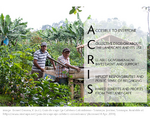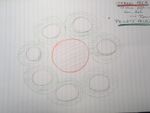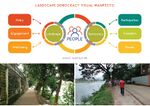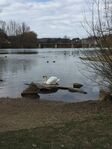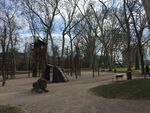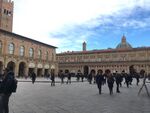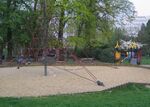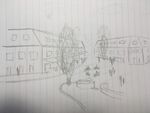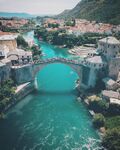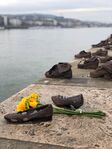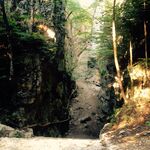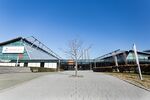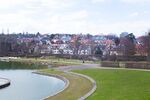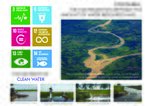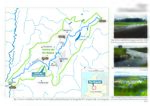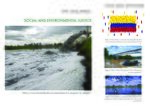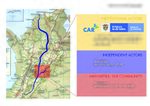LED Online Seminar 2019 - Working Group 3
--> Back to working group overview
Dear working group members. This is your group page and you will be completing the template gradually as we move through the seminar. Good luck and enjoy your collaboration!
Assignment 1 - Reading and Synthesizing Core Terminology
- You can read more details about this assignment here
- Readings are accessible via the resources page
Step 1: Your Landscape Democracy Manifestoes
Step 2: Define your readings
- Please add your readings selection for the terminology exercise before April 24:
A: Landscape and Democracy
Lynch, Kevin. (1960): The Image of the City (Shaurav Paul)
Jackson, John Brinckerhoff (1980): "By way of conclusion. How to study the landscape" (Michael)
Burckhardt, Lucius (1979): Why is landscape beautiful? (Melissa)
Sieverts, Thomas (2003): Cities without cities. An interpretation of the Zwischenstadt. (Azra)
B: Concepts of Participation
Burckhardt, Lucius (1974): Who plans the planning? in: Fezer/Schmitz (Eds.) Rethinking Man-made Environments (2012) (Azra)
C: Community and Identity
Hester, Randolph (2006): Design for Ecological Democracy (Shaurav Paul)
Welk Von Mossner, Alexa (2014): Cinematic Landscapes (Michael)
Spirn, Anne (2005): Restoring Mill Creek (Melissa)
D: Designing
Hester, Randolph: Democratic Drawing - Techniques for Participatory Design (Shaurav Paul)
Hester, Randolph: Life, Liberty and the Pursuit of Sustainable Happiness (Michael)
Smith, Nicola Dawn(2012): Design Charrette: A Vehicle for Consultation or Collaboration (Melissa)
Kot, Douglas and Ruggeri, Deni: Westport Case Study (Azra)
E: Communicating a Vision
Steps 3 and 4: Concepts Selection and definition
- Each group member selects three relevant concepts derived from his/her readings and synthesize them/publish them on the wiki by May 15, 2019
- Group members reflect within their groups and define their chosen concepts into a shared definition to be posted on the wiki by June 12, 2019.
- Other group members will be able to comment on the definitions until June 30, 2019
- Each group will also report on their process to come to a set of shared definitions of key landscape democracy concepts on the wiki documentation until July 12, 2019
Concepts and definitions
Author 1: ...
- ......
- .......
- .......
Author 2: Melissa Zapata
- DISRUPTION & LANDSCAPE: We all have a preconceived idea of landscape with an artistic palette and a charming place. However, this is a personal concept so, what make us all perceived the beauty in the landscape?. Probably is the use of the landscape itself what make us identy with the place. Is the disruption or interaction with a place what let us identify the "hiden rules" common to all of us
- SELF-KNOWLEDGE & LANDSCAPE LITERACY :As long as the community is engage to know about their past and their history in terms of landscape, better are the chances for them to face new, efficient and successful planning for their future. Thereby, having the capacity of reading their landscape though the academic partnership, the Mill Creek neighboors, were able to create extraordinary proposals away of the sense of guilt and resignation
- PARTICIPATION DESIGN PROCESS: With the aim of co-create, in terms of design, a way of trasmit knowledge and let the people be involved in the proccess of art and creation, is accesible in the most easy and effective way.. The Charrete design is mostly about an intensive period of time of collaboration work and efficiency where the work became a doble way experience of collaborators and consultants. Therefore, the democracy in the design and in the people's neccesities is a balance that garantee the long term work of the projects as well as its success
Author 3: Azra Haracic
- An interpretation of the Zwischenstadt: The concept of the Thomas Sieverts chapter 'An interpretation of the Zwischenstadt' is the idea of Zwischenstadt itself and the ways of changing it to something new, with new perspective and approaches. He is trying to explain the most important newly appeared questions about interpretation of intermediate city or city in a change with growth. Also, in his opinion, very important perspective is from cultural and political dissolution of the city which has affected the whole idea of the Zwischenstadt, actually the fact that environment they are living in has destroyed both perspectives. He refers to Kevin Lynch's mental mapping and how it is strong and different approach for the urbanized countryside, Zwischendtadt. His critical opinion of the city is, in my opinion, very much objective and realistic and different point of view of criticizing an idea of industrial periphery.
- Who plans the planning? : The concept of this reading is mainly about who really plans the planning and the way they do it. Important aspect of the planning is the decision-making part which can not always be controlled or done in the best possible way, because there are more people involved with different backgrounds (professions) and usually with different goals/intentions. It is really important for architect or urban planner to be professional and not attached in politics in order to have the best possible intention as well as outcome. Human Relations method is a good way to overcome some problems that might appear in collective decision making. Sometimes, planners are designing with their intuition and there is also one very important factor while planning: experience. Planners need experience in order to be able to create and understand the needs of specific community and create a place to be suitable for all useres.
- How One Small Community Shaped Its Future: The concept of the Case study on Crafting Westport is about the problems in economical situation and the employment problems they were faced with. The limited opportunities for job in this place made the population be involved in agriculture and mostly health care services. Anyway, the history of this city is pretty important for the California and the was a good enough reason for the project like this. Part of this process what Listening project which was a background research on the community and the quality of the life inhabitants actually have. Outcome of the whole project (goal) to improve their life and quality of it, specially the economic situation they were at the time. As they refer to community as 'family' it was clear the size of the community and the need for new residents as well as the main functioning buildings in the city. Landscape students from Berkeley were part of the project and process of developing the new master plan for Westport with priority needs for community which inhabitants pointed out in the Listening Project.
Author 4: Shaurav Paul
- MENTAL IMAGE: The imageability or the appearance of any city does not fully rely on its design, physical condition, workability or special organization. The inhabitants, users or the outsiders make an environmental image of the city in their mind and navigate there by 5 (five) physical characteristics. Those are Paths (way of movement), Edges (Physical or mental boundary to difference with the surrounding’s boundary), Districts (a piece of cake in the whole city to remember the identity), Nodes (Strategic points of connections, activities or transitions) and Landmarks (external points of reference, which dominates the usual city structures). Planners or designers nowadays consider those factors while building or rebuilding a city for the look of the city. -Lynch, Kevin. (1960): The Image of the City, Cambridge, Mass.: MIT Press
- REPRESENTATIVE REPRESENTATION: Designing a space in the participatory method is not an equal task like the normal design process. The designers use some unique and creative methods to bring out the idea from local people to implement this on the design. Rather than asking their direct opinions, designers can follow 5 steps to ensure the participatory design process with the citizens. Representing people, enhancing their knowledge, co-authoring design with them, encouraging people to represent themselves and perceiving the long term value of the design process can be the best collaborative process to figure out the "Representative Representation”- Hester, Randolph: Democratic Drawing - Techniques for Participatory Design
- RESILIENCY: To achieve the goal of Ecological Democracy in the term of city design, resiliency is the middle factor with enabling and impelling. The present city planners and designers are overlooking the concept of an ecologically sustainable city in means of designing posh, lucrative and technological city. This poor city design is creating “lost community” and nurturing a sense of community is not a prime goal now. But if we really want to make a city, where people can live with social, ecological and communal balance, we have to input the equation of creating ecological democracy in city planning. When a city and its landscape are ready to stand with short term disasters besides of creating a social connection (enabling) and a place of personal feeling (impelling), the city must stand out ahead rather than the so-called “Designed City” - Hester, Randolph (2006): Design for Ecological Democracy
Step 5: Reflection
Step 6: Revised manifestoes
- please look again at your initial manifestoes and update them with any new aspects/prespectives you have taken up during this seminar
Assignment 2 - Your Landscape Symbols
- You can read more details about this assignment here
Landscape Symbols Author 1: Melissa
This space allows the interaction between cultures, people and history. This, a strategic place in Stuttgart, seeks not only to represent the historical and cultural legacy of the city, but invites its inhabitants to enjoy the landscape, invites also to find different activities around an emblematic place and with it, allows to leave a memory of the symbols in the landscape
Landscape Symbols Author 2: Michael
This is the Piazza Maggiore in Bologna in Italy. It’s pretty simple but on this picture we can have a overview of buildings (arranged a fiew undred years ago by men) and people enjoying life in this square. It’s a place where people share, talk communicate and have a good time. Nowadays, it is a social place. Even if the building was built a long time ago it serves now a public purpose with a view on the piazza. These building physically enclose the piazza but there are still some openings with to let people walk freely. There are also some events quite frequently that people from everywhere can enjoy.)
This is a park located in Liège in Belgium. This park shows a playground where children can play and also where old people can seat around, have a walk. This is a place where people can really enjoy life, have a drink and just relax. As said just before, this place is shared by diffrent generations and so it is a good way to share their knoldege
Located in Tilff, a small village in Belgium, this is again a public place where you can see bars all around. There are some events organised quite often but this common space is a smaller scale than the other public spaces but I chose this one because, I already enjoyed a few events there. For me it is a symbol of democracy because before making any changement on this public space, the local inhabitants are requested to talk about the projects the want to do there. The final decision it take by representatives chosen by the local people.
Landscape Symbols Author 3: Azra Haracic
My first symbol is the Old Bridge in my country, Bosnia and Herzegovina, Mostar. It is the symbol of connection for two parts of the city ( both geographical and religious parts ) and it was destroyed in the war, November 1993, so people that are attacking cant cross it. After the War it was rebuilt, and it is very important for the history of Bosnia. Also, it is protected by UNESCO as a World Heritage site. For me, it is the symbol in landscape from very important period i this country and it shows the purpose of peoples democracy and their connection. In this way, some religious barriers and obstacles were a good intention for overcoming them.
My second symbol is located in Budapest, The Shoes on the Danube Bank, important for all the Jews around the world and reminder of how they were fighting to get true for that crime. It is a memorial in Budapest on the place where they were ordered to take off their shoes, and were shot at the edge of the water so that their bodies fell into the river and were carried away. This is representing their shoes left behind on the bank and I think this is a good way of symbol of democracy in landscape and big reminder for the crime which should never be repeated again. You can feel the atmosphere and sadness of the place, but still people took the courage to make it a statement through democracy and make it a symbol.
My third symbol is also in Bosnia, located near Prusac, and it is also historic sign related to Muslim people with the story behind it, how the rock opened and separated in two parts so the city has water. Ajvatovica is the largest Islamic traditional, religious and cultural event in Europe. It was named after Ajvaz Dede (Grandfather Ajvaz), and for me, he and this symbol represents the sacrifice of one for greater good. Even after more then 500 years, people still go to the water spring itself to show their appreciation and I consider this as a very powerful symbol of a landscape.
Landscape Symbols Author 4: Shaurav Paul
This is the center space of Stuttgart Messe. Here, the people are always busy with conference, exhibition or trade fair type corporate and artificial looking things. But within this place, there are some soft corners- justified with trees and natures. It shows us that nothing is perfect without a touch of nature.
Assignment 3 - Role Play on Landscape Democracy "movers and shakers"
- You can read more details about this assignment here
Assignment 4 - Your Landscape Democracy Challenge
- You can read more details about this assignment here
- Each group member will specify a landscape democracy challenge in his/her environment
SOCIAL AND ENVIRONMENTAL JUSTICE
- The contradiction. Melissa Zapata
Your references:
- ...
- ...
Landscape Democracy Challenge 2
- Give a title to your challenge
- Yourname challenge 1.jpg
caption: why did you select this case?
- Yourname challenge 2.jpg
caption: what is the issue/conflict (1)
- Yourname challenge 3.jpg
caption: what is the issue/conflict (2)
- Yourname challenge 4.jpg
caption: who are the actors?
Your references:
- ...
- ...
Landscape Democracy Challenge 3
- Historic ruins Sarajevo
- Azra Haracic challenge 1.jpg
caption: why did you select this case?
- Azra Haracic challenge 2.jpg
caption: what is the issue/conflict (1)
- Azra Haracic challenge 3.jpg
caption: what is the issue/conflict (2)
- Azra Haracic challenge 4.jpg
caption: who are the actors?
Your references:
- ...
- ...
Landscape Democracy Challenge 4
- Rampal Coal Power Plant beside Sundarban, World's Largest Mangrove Forest
- Yourname challenge 1.jpg
caption: why did you select this case?
- Yourname challenge 2.jpg
caption: what is the issue/conflict (1)
- Yourname challenge 3.jpg
caption: what is the issue/conflict (2)
- Yourname challenge 4.jpg
caption: who are the actors?
Your references:
- ...
- ...
Your Democratic Change Process
- Add Title
- Your Democratic Change Process Slide1.jpg
caption: ...
- Your Democratic Change Process Slide2.jpg
caption: ...
- Your Democratic Change Process Slide3.jpg
caption: ...
- Your Democratic Change Process Slide4.jpg
caption: ...
Reflection
- ....
- ....
- ....
Conclusion:
- ....
- ....
- ....
Your references
- ...
- ...
- ...
